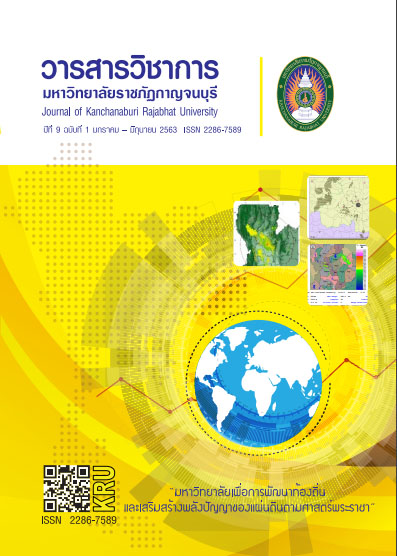PRODUCTION COST MANAGEMENT AND PROFIT PLANNING OF COMMUNITY ENTERPRISE PRODUCTS FOR LOCAL ECONOMIC ADVANCEMENT, BANG NANGRA SUBDISTRICT, BANG PAHAN DISTRICT, PHRA NAKHON SI AYUTTHAYA PROVINCE
Main Article Content
Abstract
This research aimed at analyzing production cost, determining reasonable selling prices as for creating guidelines in production cost management, and creating profit planning of community enterprise products. In this participatory action research, data were collected using deep interview. A sample consisted of a food processing community enterprise group of sweet potato in Bang Nangra subdistrict, Bang Pahan district, Phra Nakhon Si Ayutthaya province selected by purposive sampling. The research instruments adopted a questionnaire and an observation scale for data collection. The qualitative data were analyzed using production cost analysis, determination of selling prices, and profit planning by accounting calculation. The results showed that 25 community enterprise members possessed cooperative production practices, and the budget for community enterprise establishment had been supported and granted by Department of Agricultural Extension. In an analysis of product cost per unit, the product pricing had been estimated without Break-Even analysis, and an accounting system of the group was inappropriate. An analysis of production cost revealed a total cost of 24,700 THB per production cycle, and a product cost per unit of 6.175 THB/unit. The creation of profit planning using an analysis of selling price showed that the selling price of retail products was 25 THB/unit with cost-plus pricing of 300%, and the selling price of wholesale products was 20 THB/unit with cost-plus pricing of 220%. The guideline creation of production cost management showed that all raw materials used in production were cultivated in the community, and the production was operated by a group of community members in leisure time. In public relations, community groups and OTOP booths in shopping malls were established as for marketing purposes. Besides, sufficient production capacity as demanded by customers could assist in reducing product storage cost and financial management. In addition, there was a reuse of waste materials in the community e.g., cheap composed-fertilizer from cassava peel for agricultural utilization.
Article Details
References
กระทรวงเกษตรและสหกรณ์. (2560) รายงานการประชุมของความช่วยเหลือเกษตรกร. การประชุมคณะกรรมการ ครั้งที่ 3/2560 24 มีนาคม 2560. กรุงเทพฯ: ผู้แต่ง
กิ่งกนก รัตนมณีและคณะ. (2560). การศึกษาการคำนวณต้นทุนผลิตภัณฑ์ของโครงการหนึ่งตำบลหนึ่งผลิตภัณฑ์
ในจังหวัดตรัง. วารสารการจัดการสมัยใหม่, 15(1), 81
นวพร บุศยสุนทรและคณะ. (2561). การบัญชีบริหาร. กรุงเทพมหานคร : แมคกรอฮิล อินเตอร์เนชั่นแนล เอ็นเตอร์
ไพรส์ แอลแอลซี.
ประภัสสร กิตติมโนรม. (2560). การบัญชีบริหาร. กรุงเทพมหานคร : โอ. เอส. พริ้นติ้ง เฮาส์.
เพ็ญนภา หวังที่ชอบ. (2561). การวิเคราะห์ต้นทุนและระบบบัญชีต้นทุนผลิตภัณฑ์ชุมชน กรณีศึกษา :
กลุ่มจักสานหวาย บ้านวัดนาค ตำบลปากกราน อำเภอพระนครศรีอยุธยา จังหวัดพระนครศรีอยุธยา.
วารสารวิทยาการจัดการปริทัศน์, 20(1), 79
ศศิวิมล มีอำพล. (2558). การบัญชีเพื่อการจัดการ (พิมพ์ครั้งที่ 23). กรุงเทพมหานคร: เสมาธรรม.
ศรีสุดา อาชวานันทกุล. (2559). การบัญชีบริหาร (พิมพ์ครั้งที่ 3). กรุงเทพมหานคร: จามจุรีโปรดักส์.
สำนักงานเศรษฐกิจการเกษตรกระทรวงเกษตรและสหกรณ์. (2562). ส่องรายได้เงินสดเกษตร ปี 61 ผลงานรัฐ
ดันรายได้ เกษตรกรเพิ่มขึ้น ผลผลิตเกษตรได้คุณภาพ. ค้นเมื่อ สิงหาคม 12, 2562,
Anton Ovchinnikov. (2011). Revenue and Cost Management for Remanufactured Products.
Production and Operations Management. Blackwell Publishing Inc.
Hanwen Chen & Jeff Zeyun Chen & Gerald J. Lobo & Yanyan Wang. (2010), "Effects of Audit
Quality on Earnings Management and Cost of Equity Capital: Evidence from China.
"/Electronic copy available at:https://ssrn.com/abstract


